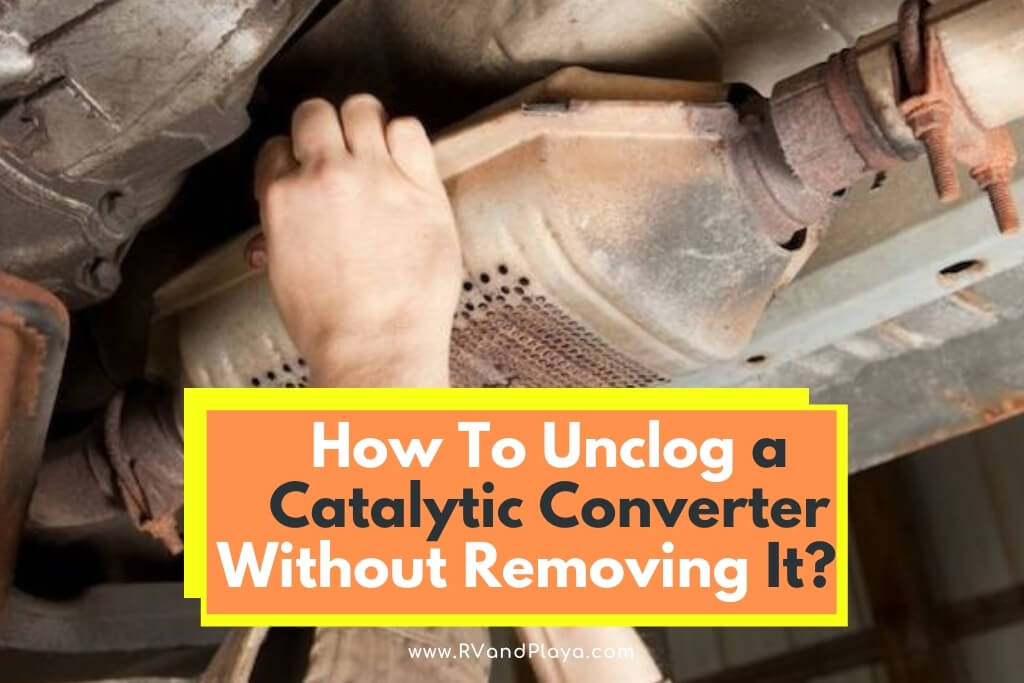Do you know how to unclog a catalytic converter without removing it? this is one of the questions our readers ask a lot. Well, we´ve got you covered.
A clogged catalytic converter will present a lot of symptoms, including a gagging smell of rotten eggs, extremely hot undercarriage, low fuel mileage, hesitant and stuttering ignition, and poor acceleration.
The ultimate symptom is a failed emissions inspection, so cleaning it should be a vehicle maintenance priority.
So, how to unclog a catalytic converter without removing it? You can clean a catalytic converter without removing it by using fuel additives, targeted catalytic converter cleaners, and a preventative maintenance additive for when you do have it adequately cleaned.
When a catalytic converter becomes too clogged, there’s not a great chance that fuel or oil additives will fix the problem. In fact, preventative maintenance additives will make it worse or clog the catalytic converter entirely.
If additives fail to solve the problem, it will either have to be removed and cleaned—still not a guarantee—or it will have to be replaced, which is an expensive alternative.
Table of Contents
Best Fuel Additives For Unclogging A Catalytic Converter
There are several additives out there that are highly reviewed and proficient at clearing moderate clogs—and sometimes heavier ones—so you can avoid having to replace the catalytic converter.
- Oxicat Oxygen Sensor; Catalytic Converter Cleaner:An entire system solution for removing clogs, carbon deposits, and soot
- Mac Auto Parts Sledgehammer:Mre technical solution that is inserted through the vacuum line before entering the catalytic converter
- Hi-Gear HG3270:Marketing endeavors claim that this will get you past an emissions test with a clean catalytic converter, along with exhaust, pistons, and valves.
- Chevron Techron Concentrate Plus:One of the cheaper options on the list, this whole system cleaner is highly rated and is considered an effective catalytic converter cleaning additive
- Gumout Multi-System Tune-Up:Another low-cost, entire system cleaner, Gumout is designed to target the deposits that clog up a cat converter, as well as those within the converter itself
Catalytic converters are built using precious metals—such as platinum and palladium—that are designed to convert harmful pollutants into gas that can safely be emitted from the exhaust.
An ineffective cat converter can no longer perform this function and fuel additives work to remove the harmful deposits that reduce a catalytic converter’s efficiency.
They are most often used—with the exception of the Mac Auto Parts Sledgehammer—by introducing them into the fuel system, directly into the tank when you stop for gas.
Most often, it is best to use them when you have half a tank or more of gasoline.
Read also: How to Clean a Catalytic Converter With Seafoam (Best Tips)
Best Oil Additives For Unclogging A Catalytic Converter
Fuel isn’t the only way to dispense additives into your vehicle’s system to clean the catalytic converter.
Oil has a degradation and burn-off process as well, that leaves a residue (in the form of sludge and deposits) that makes its way into the cat converter.
Oil additives are also an effective means towards removing the “oil poisons” that help clog up a catalytic converter and reduce its efficiency.
- Duralube Catalytic Converter Cleaner: Restores combustion efficiency by removing or reducing oil poisons in the system
- Duralube Severe Catalytic and Exhaust Treatment: Accomplishes the same as the above, with a more potent formulation
The oil additive choices that directly impact the catalytic converter are nowhere near as robust as the fuel additives.
Fortunately, their effectiveness is drastically increased when used in combination with the above-listed fuel additives.
When combined with effective fuel additives, there’s a decent chance that a heavily clogged catalytic converter can be saved.
Read also: Will A Clogged Catalytic Converter Cause Loss Of Power (Bad Catalytic, Harm Engine)
Italian Tune-Up
This method is essentially slang for driving at a high rpm, creating enough heat and air to burn off the deposits that are clogging up your catalytic converter.
There are several ways to do this. In a manual transmission vehicle, get the vehicle up between second and third gear, wait for it to approach the redline, and shift once it does.
For automatics, you’ll have to do a lot of revving while it is in the park position or find an alternative to public roads, such as a local race track.
You don’t want to end up with a speeding ticket or endanger yourself and others on the road so that you can clean your converter.
This method often works—despite the pundits, it’s often better to listen to actual mechanics and experienced people—and is especially effective when combined with the above-listed fuel and/or oil additives.
Read also: What Happens When The Catalytic Converter Goes Bad (Symptoms)
Preventative Maintenance
The best way to clean a catalytic converter is to never have to clean it at all. Preventative maintenance is important for more than just the cat converter.
Keeping your fuel and oil systems free of deposits, pollutants, and sludge will keep your vehicle in a state of reliability and longevity.
How I Figured Out Exhaust Restriction (Clogged Catalytic Converter) >> Check the video below:
There are several additives that are good for just this sort of purpose and they’re often confused with actual catalytic converter cleaners.
However, they aren’t the same in the sense that they don’t directly clean a cat converter but keep your system from producing the deposits that will clog it.
- Seafoam: Seafoam manufactures several different fuel and oil additives that work to clean your entire system of oil poisons, deposits, sludge, and other detrimental residues
- Berryman: Berryman sells products that act in a similar fashion to Seafoam, from targetted cleaners to whole-system cleaners
Timely Oil Changes are just as effective as any oil or fuel additives in acting as a preventative maintenance tool.
Oil loses its viscosity over time, picks up deposits, becomes sludgy, and generally loses its ability to properly lubricate critical engine parts.
The problem with old oil is that it produces more of the “oil poisons” you’re trying to avoid. Be sure to only use oil that is rated for the weight your manufacturer recommends.
Its also important to change the oil on time and use high-quality, brand-name engine oil only.
In other words, don’t shop for your vehicle’s next oil change at Winn Dixie and pick up the generic Winn Dixie brand in the dog food aisle.
When your vehicle reaches a certain mileage—like 75,000—switch to high-mileage oils and stick to a routine schedule.
Premium and Plus Fuels are also excellent preventative maintenance techniques. Oftentimes, the premium fuel at your local gas station contains some or all of the same additives found in the catalytic converter cleaners listed above.
Sure, gas is really expensive right now, so you don’t have to stick with the premium brand all of the time, every time you fill-up.
Switch it up and fill up with premium once every two weeks. Once every month isn’t quite as good, but it’s a long shot better than nothing at all.
Some fuel additives can get expensive and some may be more cost-effective than filling up with a premium brand.
Do some homework and see what the fuel additive contains in relation to the premium brand at the gas station you use most often. You may find a better deal this way.
Read also: Can A Clogged Catalytic Converter Cause A Misfire (Faulty Converter Code)
Final Word
You never want to find yourself on the bad side of a failing catalytic converter. The best way to avoid that is to stay on top of your vehicle’s maintenance.
It’s often said that a vehicle will go a long way so long as you change the oil on time, and tune it up regularly.
Nothing could be closer to the truth.
Once a catalytic reaches the red line between barely operational and failure, not even the most expensive fuel and oil additives on the market may be enough, so prepare accordingly.
Here are some of my favorite tools & equipment´s
Thank you for reading this article. I hope it helps you find the most recent and accurate technical and repair information for your car. Here are some tools that I use as an automotive technician and hope you´ll also find helpful.
There are affiliate links, so if you do decide to use any of them, I´ll earn a small commission. But in all honesty, these are the exact tools that I use and recommend to everyone, even my own family. (NO CRAP)
To see all my of most up-to-date recommendations, check out this resource that I made for you!
References
Retrieved from: https://greenhousecenter.net/
Recent Posts
How Much Does it Cost to Unclog a Catalytic Converter (Replacement Cost)
Have you ever asked yourself how much does it cost to replace or unclog a catalytic converter? Well, you are at the perfect place to find the answer to such a question. You might find your car is...
Your catalytic converter is a huge part of your vehicle’s exhaust system. When working properly, the catalytic converter treats all of the exhaust gases released from the engine to remove any...


